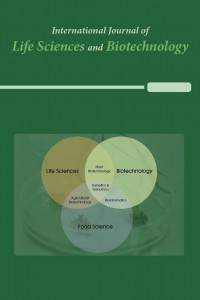A Review of Approaches in Steviol Glycosides Synthesis
A Review of Approaches in Steviol Glycosides Synthesis
Stevia, Stevia rebaudiana, steviol glycoside, transcriptome,
___
- Ceunen, S., Werbrouck, S., & Geuns, J. M. Stimulation of steviol glycoside accumulation in Stevia rebaudiana by red LED light. Journal of plant physiology, 2012. 169(7), 749-752.
- Chen, J., Hou, K., Qin, P., Liu, H., Yi, B., Yang, W., & Wu, W. RNA-Seq for gene identification and transcript profiling of three Stevia rebaudiana genotypes. BMC genomics, 2014.15(1), 571.
- Gupta, P. Plant tissue culture of Stevia rebaudiana (Bertoni): A review. Journal of Pharmacognosy and Phytotherapy, 2013. 5(2), 26-33.
- Gupta, P., Sharma, S., & Saxena, S. Effect of salts (NaCl and Na 2 CO 3) on callus and suspension culture of Stevia rebaudiana for steviol glycoside production. Applied biochemistry and biotechnology, 2014. 172(6), 2894-2906.
- Ijaz, M., Pirzada, A. M., Saqib, M., & Latif, M. Stevia rebaudiana: An alternative sugar crop in Pakistan–a review. Erling Verl. GmbH Co. KG, 2015. 20(2), 88-96.
- Kampranis, S. C., & Makris, A. M. Developing a yeast cell factory for the production of terpenoids. Computational and structural biotechnology journal, 2012. 3(4), e201210006.
- Karimi, R., Vahedi, M., Pourmazaheri, H., & Balilashaki, K. Biotechnological approaches in Stevia rebaudiana and its therapeutic applications. Advances in Biomedicine and Pharmacy, 2017. 4(1): 31-43. Kim, M. J., Jin, J., Zheng, J., Wong, L., Chua, N. H., & Jang, I. C. Comparative transcriptomics unravel biochemical specialization of leaf tissues of Stevia (Stevia rebaudiana) for diterpenoid production. Plant physiology, 2015. pp-01353.
- King, R. M., & Robison, H. The Genera of the Eupatorieae (Asteraceae), Monographys in Systematic Botany, The Missouri Botanical Garden, 1987. KING, RM; ROBINSON, H., Eds.
- Kong, M. K., Kang, H. J., Kim, J. H., Oh, S. H., & Lee, P. C. Metabolic engineering of the Stevia rebaudiana ent-kaurene biosynthetic pathway in recombinant Escherichia coli. Journal of biotechnology, 2015. 214, 95-102.
- Lucho, S. R., do Amaral, M. N., Milech, C., Ferrer, M. Á., Calderón, A. A., Bianchi, V. J., & Braga, E. J. B. Elicitor-Induced Transcriptional Changes of Genes of the Steviol Glycoside Biosynthesis Pathway in Stevia rebaudiana Bertoni. Journal of Plant Growth Regulation, 2018. 1-15.
- Nature. https://www.nature.com/subjects/transcriptomics (accessed on 5 July 2018).
- Ohto, C., Muramatsu, M., Obata, S., Sakuradani, E., & Shimizu, S. Prenyl alcohol production by expression of exogenous isopentenyl diphosphate isomerase and farnesyl diphosphate synthase genes in Escherichia coli. Bioscience, biotechnology, and biochemistry, 2009. 73(1), 186-188.
- Modi, A., Litoriya, N., Prajapati, V., Rafalia, R., & Narayanan, S. Transcriptional profiling of genes involved in steviol glycoside biosynthesis in Stevia rebaudiana bertoni during plant hardening. Developmental Dynamics, 2014. 243(9), 1067-1073.
- Singh, S. D., & Rao, G. P. Stevia: The herbal sugar of 21 st Century. Sugar tech, 2005. 7(1), 17-24.
- Singh, G., Singh, G., Singh, P., Parmar, R., Paul, N., Vashist, R., & Kumar, S. Molecular dissection of transcriptional reprogramming of steviol glycosides synthesis in leaf tissue during developmental phase transitions in Stevia rebaudiana Bert. Scientific reports, 2017. 7(1), 11835.
- Sys, E. A., Marsolais, A. A., & Brandle, J. 1998. U.S. Patent Application No. 08/652,712.
- Tamokou, J. D. D., Mbaveng, A. T., & Kuete, V. Antimicrobial activities of African medicinal spices and vegetables. In Medicinal Spices and Vegetables from Africa 2017. (pp. 207-237).
- Valio, I. F. M., & Rocha, R. F. Effect of photoperiod and growth regulator on growth and flowering of Stevia rebaudiana Bertoni. Japanese Journal of Crop Science, 1977. 46(2), 243-248.
- Yadav, A. K., Singh, S., Dhyani, D., & Ahuja, P. S. A review on the improvement of stevia [Stevia rebaudiana (Bertoni)]. Canadian Journal of Plant Science, 2011. 91(1), 1-27.
- Yadav, S. K., & Guleria, P. Steviol glycosides from Stevia: biosynthesis pathway review and their application in foods and medicine. Critical reviews in food science and nutrition, 2012. 52(11), 988-998.
- Yoneda, Y., Nakashima, H., Miyasaka, J., Ohdoi, K., & Shimizu, H. Impact of blue, red, and far-red light treatments on gene expression and steviol glycoside accumulation in Stevia rebaudiana. Phytochemistry, 2017. 137, 57-65.
- Zaidan, L. B., Dietrich, S. M., & Felippe, G. M. Effect of photoperiod on flowering and stevioside content in plants of Stevia rebaudiana Bertoni. Japanese Journal of Crop Science, 1980. 49(4), 569-574.
- Yayın Aralığı: Yılda 3 Sayı
- Başlangıç: 2018
- Yayıncı: International Society of Academicians
Isolation of bacteria from Tuz Gölü lake that can grow on high salt concentration
Jyng Sheng TEE, Yilmaz KAYA, Fahrul Zaman HUYOP
Bolu ve Tokat İllerindeki Buğday Sap Atıklarının Enerji Potansiyel Değerlerinin Teorik Analizi
Muhammed TAŞOVA, İsmail NANELİ
Fitoöstrojenik Bitkiler; Ne Kadar Tüketilmeli?
Rabia Vildan SOLDAMLI, Sahane Funda ARSLANOGLU
Narayan KHATRİ, Bisheshwor Prasad PANDEY, Mamata BİSTA, Dev Lakshmi GHİMİRE
Alpha S1-Casein Gene Polymorphısm in Nigerian Balami Sheep Breed Indigenous to Mubi
İsmaila Yada SUDİ, Mohammed SHUAİBU, Malachi Albert TİZHE
Fusarium culmorum ile Enfekte Edilen Arpa Çeşitlerinde WRKY Transkripsiyon Faktörlerinin Analizi
Ebru ULUHAN, Esra Nur KELEŞ, Feyza TUFAN
Effects of Potato Virus Y Strains on Local Tomato Genotype “Sazlıca”
Musadik Abdullahi AHMED, Eminur ELÇİ
A Review of Approaches in Steviol Glycosides Synthesis
Nurul Hidayah SAMSULRİZAL, Zarina ZAİNUDDİN, Abdul Latif NOH, Tamil Chelvan SUNDRAM
Plants as Potential Repellent Against Oryzaephilus Species
Nurul Huda ABDUL, Nor Hafizah ZAKARİA, Maizatul Akma IBRAHİM
